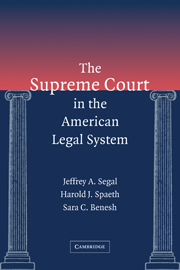Book contents
10 - Staffing the Court
Published online by Cambridge University Press: 05 June 2012
Summary
I plead with you that, whatever you do, don't try to apply the rules of the political world to this institution; they do not apply. The last political act we engage in is confirmation.
– Justice Clarence Thomas (C-SPAN), on the day after Bush v. GoreAt the end of the Supreme Court's 1990 term, Thurgood Marshall announced his retirement. Marshall, a towering figure as a litigator for the National Association for the Advancement of Colored People (NAACP) Legal Defense Fund, Inc., successfully argued Brown v. Board of Education and dozens of other cases before the Court. He made history as a member of the Court, though more for what he was – the first African American to sit on the tribunal – than for anything he did. Faced with replacing him, President George H. W. Bush quickly nominated Clarence Thomas to the Court. In reply to charges that Bush nominated Thomas because he was black, Bush responded that Thomas was “the best man for the job on the merits. And the fact that he's a minority, so much the better.”
Clarence Thomas was an outspoken conservative who curried favor in the Reagan and the elder Bush administrations by speaking forcefully against affirmative action. Under Reagan he served as director of the Civil Rights Office in the Department of Education and then as chairman of the Equal Employment Opportunity Commission (EEOC).
- Type
- Chapter
- Information
- The Supreme Court in the American Legal System , pp. 245 - 274Publisher: Cambridge University PressPrint publication year: 2005

